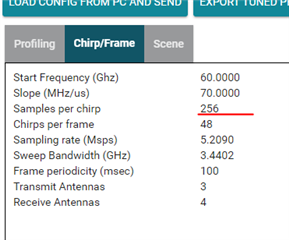Hello, TI team,
I have a question about 'Max Unambiguous Range' displayed in mmWave demoVisualizer.
Simply thinking, max unambiguous range is range resolution * sample per chirp I think.
But, in demoVisualizer, max unambiguous range is 0.8 * range resolution * sample per chirp.
Could you let me know the meaning of 0.8 ?
For example, when saple per chirp is 256, range resolution is 0.0436, max unambiguous range is
0.8 * 0.0436 * 256 = 8.929
please see the picture below.
Regards,
Kei



